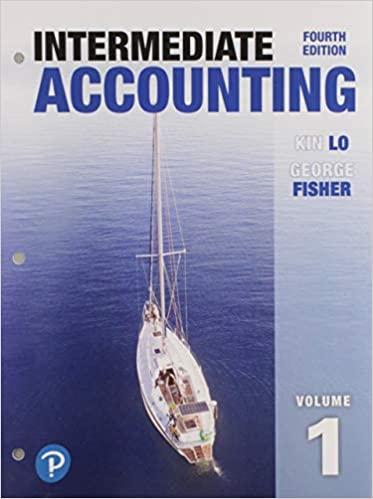Question
Events Balance Sheet Assets Liab Equity Cash Acct Rec Inventory Equipment Land Building - Accum Depr Acct Payable Div Payable Notes Payable Wages Payable Common
| Events | Balance Sheet | ||||||||||||||
| Assets | Liab | Equity | |||||||||||||
| Cash | Acct Rec | Inventory | Equipment | Land | Building | - | Accum Depr | Acct Payable | Div Payable | Notes Payable | Wages Payable | Common Stock | APIC | Retained Earnings | |
| Acquired $550,000 by signing a note payable with a local bank | $ 550,000 | $ 550,000 | |||||||||||||
| Sold 25,000 shares of $22 Common Stock for $1,500,000 | $ 1,500,000 | - | $ 550,000 | $ 950,000 | |||||||||||
| Purchased Equipment | $ (200,000) | $ 200,000 | - | ||||||||||||
| Purchased Inventory on Account - 25,000 Units at $1.15 per unit | $ 28,750 | $ 28,750 | |||||||||||||
| 5a. Sold 15,000 units at $3.50 on Account | $ 52,500 | - | $ 52,500 | ||||||||||||
| COGS for Sales on Account | $ (17,250) | $ (17,250) | |||||||||||||
| Collect $70,000 on Account | $ 70,000 | $ (70,000) | - | ||||||||||||
| Paid $17,250 of Accounts Payable | $ (17,250) | $ (17,250) | |||||||||||||
| Purchased Inventory on Account - 170,000 Units at $1.50 per unit | $ 255,000 | - | $ 255,000 | ||||||||||||
| Sold 175,000 units at $3.50 on Account | $ 612,500 | - | $ 612,500 | ||||||||||||
| COGS for Sales on Account | $ (201,250) | - | $ (201,250) | ||||||||||||
| Collect $472,500 on Account | $ 472,500 | $ (472,500) | - | ||||||||||||
| Paid $118,600 of Accounts Payable | $ (118,600) | - | $ (118,600.00) | ||||||||||||
| Purchased Inventory on Account - 275,000 Units at $1.45 per unit | $ 398,750 | - | $ 398,750 | ||||||||||||
| Sold 200,000 units at $3.50 on Account | $ 700,000 | - | $ 700,000 | ||||||||||||
| COGS for Sales on Account | $ (270,750) | - | $ (270,750) | ||||||||||||
| Collect $735,000 on Account | $ 735,000 | $ (735,000) | - | ||||||||||||
| Paid $294,150 of Accounts Payable | $ (294,150) | - | $ (294,150.00) | ||||||||||||
| Purchased Inventory on Account - 300,000 Units at $1.15 per unit | $ 345,000 | $ 345,000.00 | |||||||||||||
| Paid Sales & Marketing Expenses of $30,000 | $ (30,000) | - | $ (30,000) | ||||||||||||
| Paid Operating Expenses of $75,708 | $ (75,708) | - | $ (75,708) | ||||||||||||
| Paid Wage Expenses of $40,000 | $ (40,000) | - | $ (40,000) | ||||||||||||
| Paid Product Line Research & Development Expenses of $150,000 | $ (150,000) | - | $ (150,000) | ||||||||||||
| Paid Advertising Expenses of $87,500 | $ (87,500) | - | $ (87,500) | ||||||||||||
| Made the yearly required payment on the note payable. The note carries a 7% interest rate and requires payments of $50,000 plus interest each December 31. | $ (88,500) | $ (50,000) | $ (38,500) | ||||||||||||
| Record Yr 1 Depreciation on Equipment with Salvage Value of $38,000 & useful life of 7 Yrs | - | $ (23,143.00) | $ (23,143) | ||||||||||||
| Declared a $10,000 cash dividend for stockholders | $ 10,000.00 | $ (10,000) | |||||||||||||
| Paid a $10,000 cash dividend for stockholders | $ (10,000) | $ (10,000.00) | |||||||||||||
| Balance at end of Yr 1 | $ 2,215,792 | $ 87,500 | $ 538,250 | $ 200,000 | $ - | $ - | - | $ (23,143) | $ 597,500 | $ - | $ 500,000 | $ - | $ 550,000 | $ 950,000 | $ 420,899 |

Flexible budget (using template provided) to include the following assumptions:Three sales volume levels (additional details below)Sales Revenue at a projected sales price of $3.50 per unit at each volume levelCost of Goods Sold (use FIFO method to record inventory purchases in the accounting equation and weighted average method to calculate break-even point) Operating Expenses Fixed Costs pulled from your accounting equation worksheet.Check Figure/Reflection - Does your calculated Net Income tie out to your accounting equation worksheet for your actual sales column? Why or why not?Calculate the required purchases for a desired ending inventory of $35,000, assuming your ending inventory from the accounting equation worksheet is your beginning inventory for budgeting purposes.A break-even calculation (show your work on the excel file) of how many units you need to sell in order to break-even.

Step by Step Solution
There are 3 Steps involved in it
Step: 1

Get Instant Access to Expert-Tailored Solutions
See step-by-step solutions with expert insights and AI powered tools for academic success
Step: 2

Step: 3

Ace Your Homework with AI
Get the answers you need in no time with our AI-driven, step-by-step assistance
Get Started


